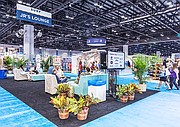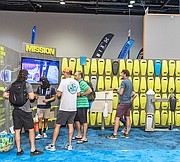TRADE SHOWS
Surf Expo Avoids the Perfect Storm This Year
ORLANDO, FLA.—A year after officials closed the Surf Expo show as Hurricane Irma fast approached, the show welcomed eager retailers from throughout the Southeast and the Caribbean—many of whom have weathered more than just storms since then.
Buyers on both coasts of South Florida, for example, have had to deal with everything from rainy holiday weekends to toxic algae blooms.
“A Red Tide on Florida’s Gulf Coast Has Been a Huge Hit to Tourism,” read the New York Times headline on the second day of Surf Expo at the Orange County Convention Center.
The red algae bloom, which technically began in October, extends from Tampa Bay down the southwestern side of the state to Naples, covering about 120 miles of coastline. The weekend before the show, officials in one county collected more than 17 tons of dead fish.
So, perhaps not surprisingly, Surf Expo attendance for the Sept. 6–8 event appeared to be down from years past. But buyers who were in attendance were ordering with growth in mind.
“I’m sticking with appointments but building in time to see new stuff,” said Wilda Camacho, executive buyer for Surf Style Retail Management, a 24-store chain based in Hollywood, Florida. “I’m doing more scouting this year.”
She said sales in coastal locations including Alabama, Mississippi and Florida’s Gulf Coast were stronger this year. “Tourism might be up over last year,” she explained.
The ability to juggle stock as seasonal traffic shifts helps. “I’m looking [for delivery in] October/November in stores like Clearwater [Florida], but for Alabama and Mississippi, we’ll look for January delivery.”
Surf Expo’s vast offerings—with categories tailored not just to the surf and swimwear industry but also to gift, footwear, resort and sports fishing—meant buyers in every niche could track down resources that were both stylish and functional.
Many of the busiest booths featured collections where technical fabrications dovetail with stylish details and sophisticated silhouettes.
“We’re on the bandwagon with sustainable swimwear,” said Holahan Swimwear’s Jamie Holahan, whose 3-year-old, high-end Sarasota, Fla.–based line picked up several new accounts.
The high-end line manufactured in the U.S. is made of sustainable polyamide fashioned from recycled fishing nets by Italian textile house Carvico. “We pay an exorbitant amount per yard for the fabric and the lining, but we take less of a markup. We’d rather take less per suit and have great swimwear and be true to our clients,” Holahan said.
Although he manufactures small lots in Sarasota, larger orders are produced in Philadelphia.
South Florida–based swimwear lines with production in Colombia were busy, such as first-time exhibitor Awamare Waterwear, which featured long-sleeved, reversible tanks, and Phax Swimwear, with embellished separates and one-pieces.
One-pieces were a singular, notable trend at a show known for the skimpiest of bikinis from exhibitors with their fingers on the pulse of global beach style. One-pieces are stronger than ever in juniors.
“It’s just a trend we’re seeing,” said Jennifer Randall, executive vice president at Miami-based swimwear line InGear Fashions Inc. “There are just more one-pieces in the juniors market, whereas before they wouldn’t be caught dead in one-pieces.”
Randall credits the trend to attention-getting details, including grommets, mesh and silhouettes that are sexy yet provide coverage and flexibility.
Buyers also are sticking with trends that have been popular for the last two years, she explained, like whipstitch detailing, tassels and fringe. Destination-specific “name-drop” bathing suits remain strong. “They’re always popular in resort areas,” Randall noted.
Across the show floor, trends existed to suit every niche. Unconventional silhouettes featured conservative fabrications like stripes, plaids and gingham while more-conventional styles emphasized embellishments and less-traditional treatments including mesh, pom-poms, tassels, whipstitch, embroidery, keyhole and lace-up detailing.
Caribbean buyers, many of whom are still recovering from last year’s storms, were a strong presence. “This show is more of an island Caribbean customer,” said InGear’s Randall. “We’re seeing a lot of new accounts, too—mostly beach shops.”
Daneanne Minto with the Bamboo Beach Club in Ocho Rios, Jamaica, made time to track down new and existing resources, she said.
Katrina Herman with Moab, Utah–based Lost River Clothing saw “lots of Caribbean accounts in recovery mode now” that were stocking up with her line’s knits and cover-ups.
Even as rolling racks made their way toward the exit before noon on the show’s last day, buyers took advantage of the opportunity to track down new, customer-friendly brands. Maddy Guenther, owner of Bo-Tiki in Gulfport, Fla., filmed and posted a video of herself at the Dona Bela Shreds booth.
“I’m here looking for lines for my new store,” she explained. After 10 years in business, she’s opening a men’s store next door—to be called Bro-Tiki—looking to capitalize on the growing millennial population in her Tampa Bay market. “I can’t believe I’ve been in business this long,” she said with a laugh. Just an hour and a half away from her store, she said, Surf Expo’s like a mini-vacation. “I get to get out of town and look for that next great thing.”
Photos courtesy of Surf Expo.


























